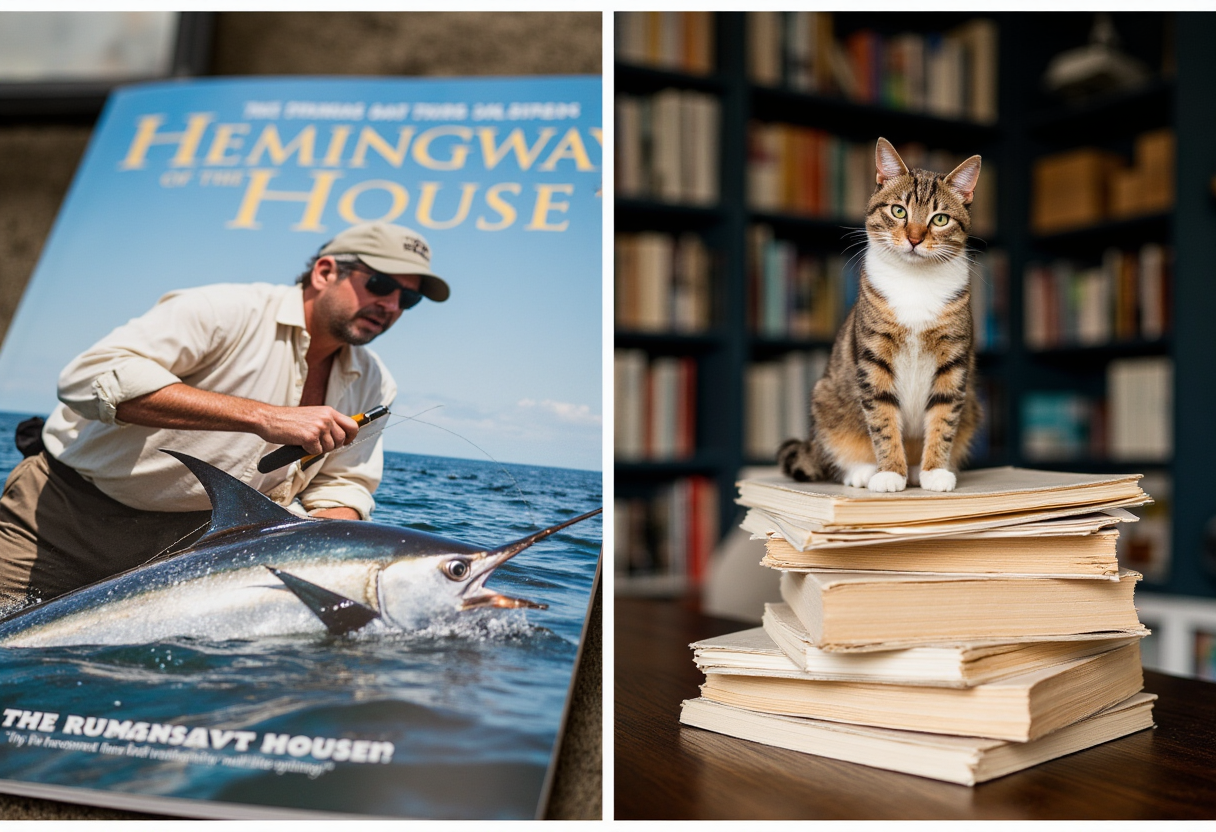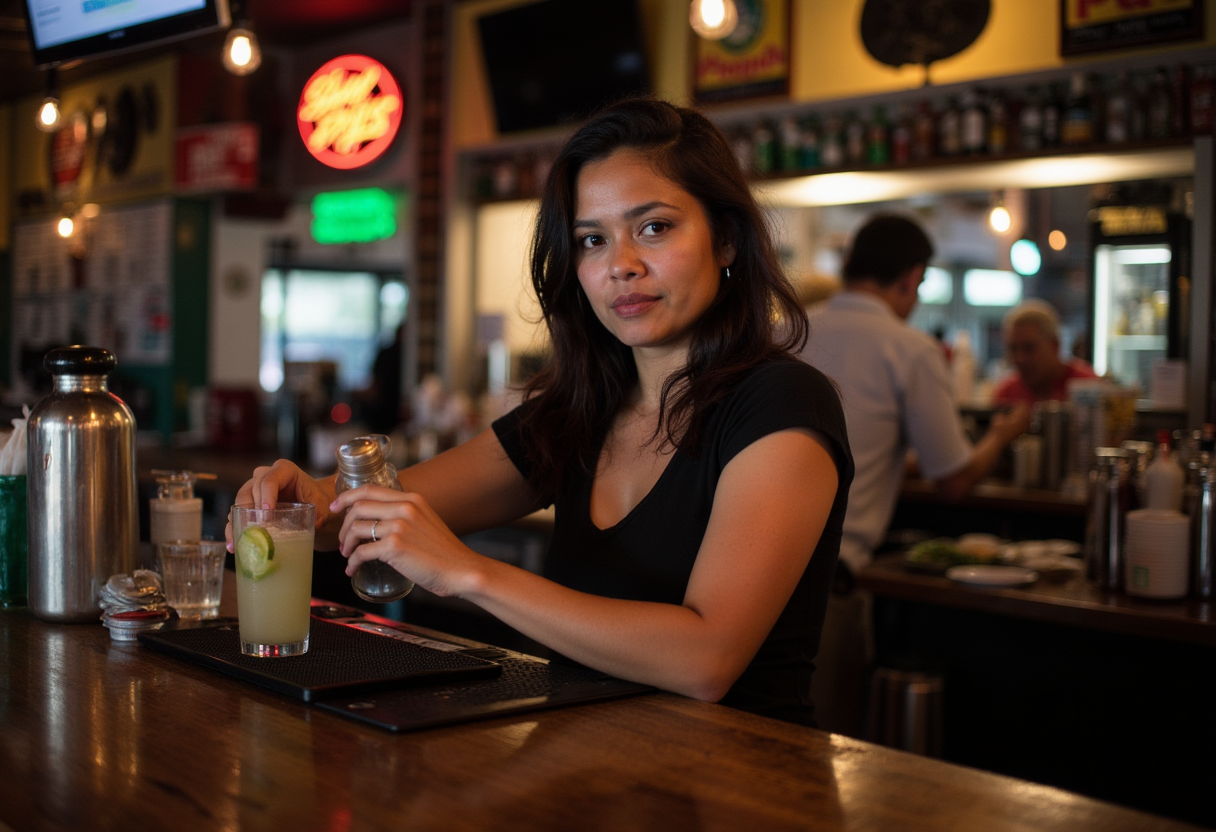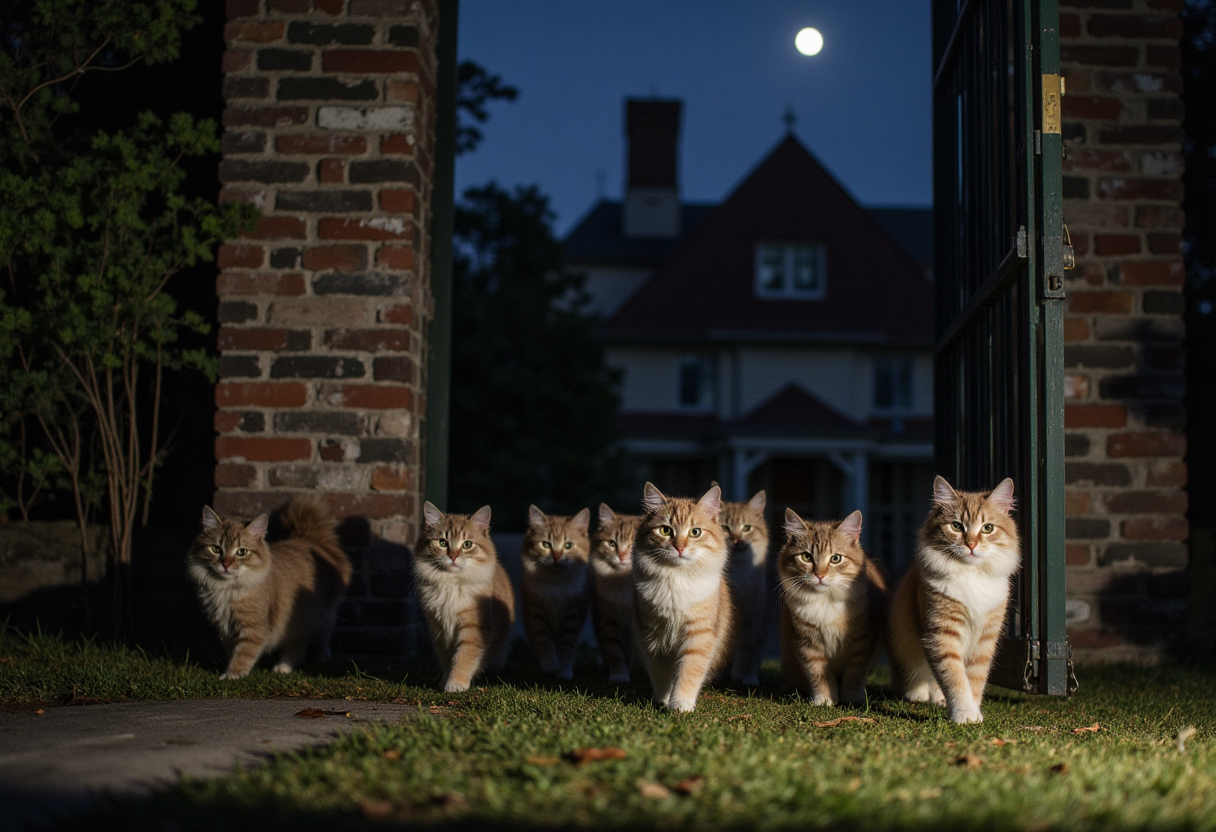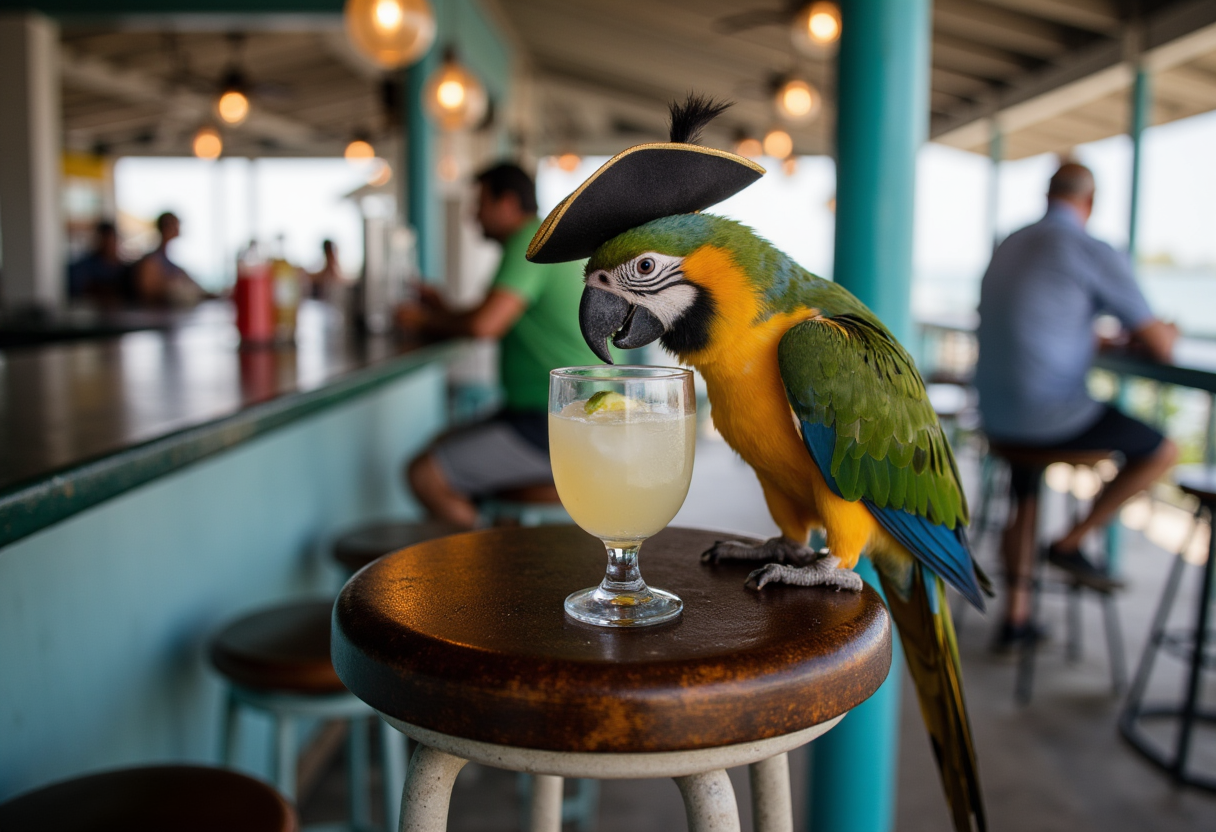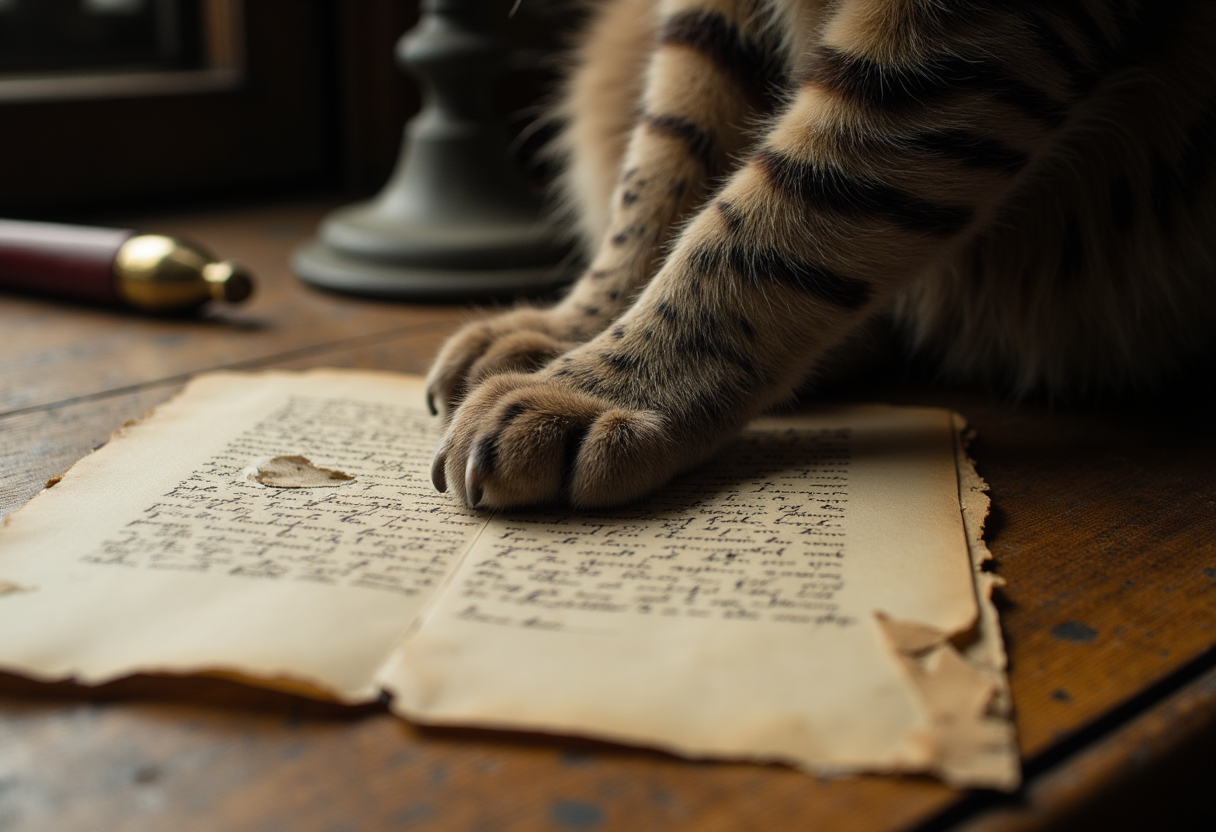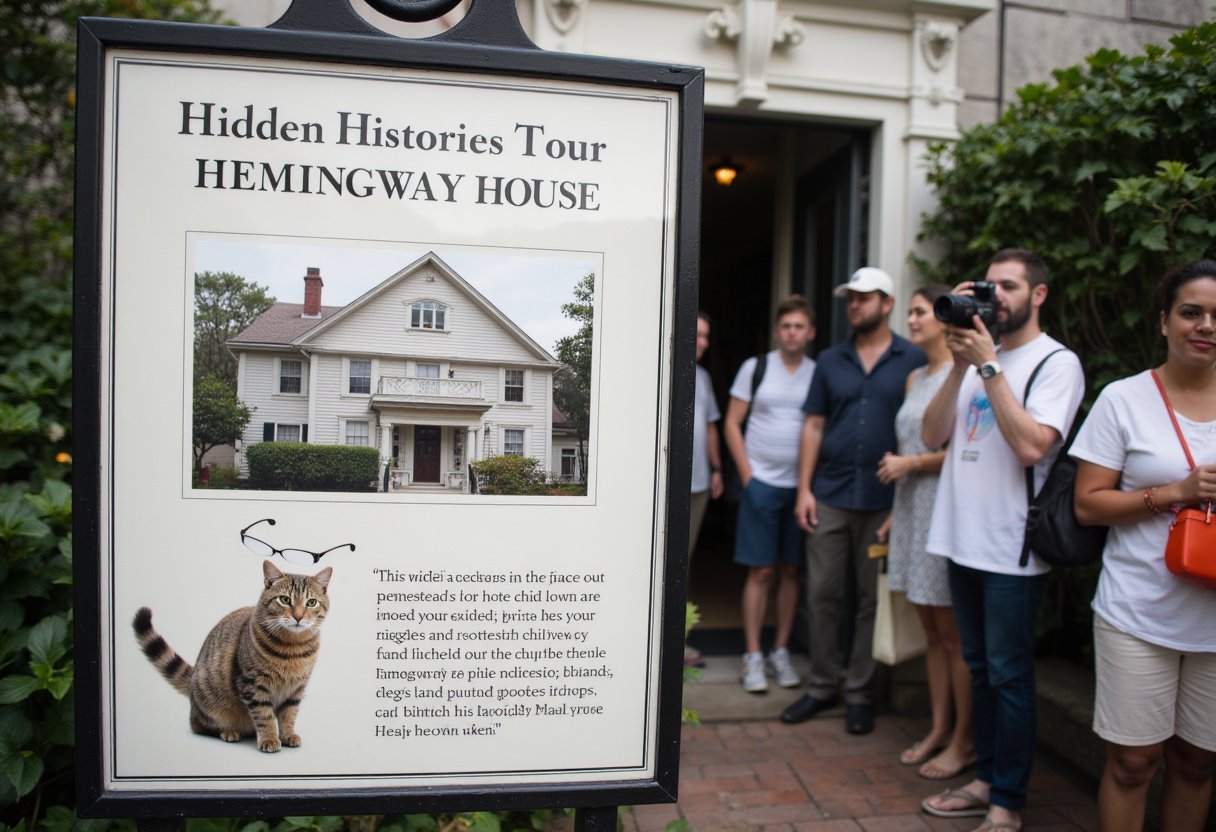The Haunting of Hemingway House: A Tale of Cats, and Literary Shenanigans
"A stylized split-screen image: On one side, a glossy, idealized tourist brochure for the Hemingway House depicting a rugged, cigar-chomping Hemingway fishing a marlin. On the other side, a subtle, intriguing image of a six-toed cat sitting proudly on a stack of ancient, newly discovered manuscripts
“The air in Key West thickens at dusk, and the cats don’t blink.”
Key West evenings have a way of turning ordinary moments strange — warm light, salt air, and the slow, certain swagger of this island’s history. At the center of it all sits the Hemingway House, a sun-bleached home museum that draws literary tourists and curious locals alike.
Maya Rodriguez arrived on the island six months earlier and took a job behind the bar at Sloppy Joe’s. By day, she poured mojitos just blocks from Ernest Hemingway’s former residence; by night, she wandered the neighborhood, learning the rhythms of the house and the street.
Stumbling onto the legendary Hemingway House felt perfectly Key West — more surreal than a parrot in a pirate hat. Whether you come for the writing, the history,
or the famously photogenic cats, stay with us: read on to see what Maya discovered inside that might change how we think about this estate and its stories.
Sloppy Joe’s to Secret Scrolls: Maya’s Midnight Meanderings
Maya drifted into Key West six months earlier, drawn by its bohemian energy, pastel houses, and the whispered promise of literary ghosts. By day she mixed mojitos at Sloppy Joe’s; by night she walked the neighborhood, learning the rhythms of the street and the odd little ways of the houses that line it.
Her shift ended just blocks from Ernest Hemingway's iconic former residence on Whitehead Street. The Hemingway House at 907 Whitehead has a way of settling into your peripheral vision — a weathered, sunlit presence that feels like part of the island itself.
"Maya Rodriguez, an intrepid new bartender, mixing a mojito at the iconic bar of Sloppy Joe's
She knew the tourist lines: Papa’s fishing, his drinking, his tough prose. But recently the house felt different. At dusk the shadows grew livelier, and the six-toed cats that have become a fixture of the grounds began to behave oddly.
Hemingway’s polydactyl descendants — the famously photogenic cats that pose for selfies by day — started moving with uncanny purpose at night. They stopped acting like lazy house pets and began behaving like a small, very fluffy secret society.
The Polydactyl Prophecy Unfolds: Cats with a Cause
The cats—yes, the cats. Any visitor to the Hemingway House will tell you they’re a major draw.
More than fifty descendants of Papa’s famous Snow White roam the grounds, each a charming genetic anomaly with an extra digit or two. By day they nap in sunbeams, pose for selfies, and embody the relaxed Key West vibe. By night, Maya began to notice something else: purpose.
They weren’t merely loafing; they were organizing. They were strategizing. In short, these polydactyl residents moved with an uncanny, coordinated intent that made Maya follow them one sultry evening after her shift at Sloppy Joe’s.
Through an ajar gate she slipped into Papa’s writing room and found the study alive with movement. The cats weren’t scattered on the antique furniture — they were working at Hemingway’s very own desk.
"A cadre of fluffy, fat-pawed polydactyl cats, moving with a mysterious, purposeful precision at night,
Vintage typewriter keys, brittle paper fragments, and what looked like previously unknown manuscript pages lay arranged with baffling care. With their extra toes acting like delicate, fur-covered tweezers, the six-toed cats appeared to be assembling a historical jigsaw — and they were good at it.
Uncovering Lost Manuscripts (and a Few Hidden Laughs)
Maya watched, jaw slack, as the cats pieced pages together. These fragments didn’t read like the marlin-and-bullfighting material Hemingway is famous for. Instead, the fragile sheets suggested a different Key West: a hidden network of LGBTQ+ people who found refuge and community on the island during the 1930s.
If true, the content could reframe parts of Ernest Hemingway’s life and work — not by replacing his novels or short stories but by adding a new, compassionate context to the era he wrote about. Imagine some of the island’s quietest histories emerging from between the paws of its most photogenic residents.
Note: these manuscript fragments are alleged discoveries and must be authenticated through archival and forensic study before historians rewrite the record. For now, they remain a tantalizing, hilarious possibility — the kind of posthumous surprise only Key West could stage, with a little help from a whole lot of clever cats.
The Tourist Industry Dilemma: Selling Hemingway vs. Selling History
The next morning, Maya—still buzzing from her feline-led dig—called Dr. Sarah Chen, a literary historian who studies Ernest Hemingway’s Key West years. Dr. Chen, after squinting at Maya’s blurry, cat-assisted photos of the manuscript fragments, went from delighted to alarmed in a heartbeat.
"These discoveries could reshape how we understand his Key West period," she said, over an iced coffee. "But Maya, think about the tourism industry. The current Hemingway House narrative sells adventure, machismo, and a romanticized literary life. This is nuance."
Nuance, as Dr. Chen and Maya both knew, doesn’t always translate to souvenir sales. Key West depends heavily on literary tourism: the Hemingway House home museum is one of the island’s leading attractions,
drawing thousands of people each year who come to visit the estate, see the pool and the grounds, and take photos with the famous cats.
Would visitors still flock to 907 Whitehead if the official story expanded to include these alleged LGBTQ+ histories? Or would some tours and marketing teams worry that a shift toward complicated truths might disrupt the family-friendly image that helps sell trinkets and tickets?
"A classic Key West scene: a parrot with a tiny pirate hat perched on a bar stool, sipping a margarita from a miniature glass.
Resistance (and Delight) from the Establishment
Word spread across Key West, and reactions split predictably. Tourism board members voiced concern about upending successful marketing strategies; local business owners who rely on the Hemingway brand nervously weighed the potential economic impact.
At a heated town hall, the museum director warned that unverified materials could be forgeries aimed at capitalizing on current trends.
These claims—about visitor numbers, marketing investments, and the director’s remarks—should be treated as reported reactions and checked against official statements and tourism data before publication. Verified facts (such as official annual attendance figures for the museum) should be cited precisely to avoid confusion between humor and documented reality.
The debate set the stage for a grassroots response, one that would test whether the Hemingway House could balance its role as a national historic site and celebrated attraction with a more complete, inclusive account of its past.
The Cats: Unfazed, Undeterred, and Unwavering
Even as debates swirled, the polydactyl cats on the Hemingway House grounds carried on as if human concerns were mere background noise. Maya, now unofficially deputized as their human liaison, began carefully documenting their nocturnal patterns.
A close-up of a six-toed cat's paw, with its extra digits acting like fur-covered tweezers, delicately placing a fragment of aged, yellowed manuscript page
She noticed rhythms to their movements—almost astrological in timing—that seemed to sync with the phases of the moon. On certain nights the cats revealed new manuscript pages, each page adding another piece to an emerging picture of Key West’s marginalized communities in the 1930s.
Perhaps they were simply excellent at time management. Or perhaps the island’s most famous animals had become unlikely archivists.
According to the alleged fragments, the manuscripts told stories of courage and community: a transgender bartender who found acceptance in some of Key West’s bars, a same-sex couple who ran a boarding house offering shelter to LGBTQ+ refugees, and a network of artists and writers who quietly supported one another decades ahead of mainstream acceptance.
One particularly moving passage—still awaiting verification—described a secret wedding held in the Hemingway House garden, officiated by a sympathetic ship captain and witnessed by a small,
diverse group who had found chosen family on the island. These scenes suggest that Papa’s backyard and the surrounding estate were more than a picturesque set for tours; they may have been a genuine refuge for people who needed one.
Note for editors: the human stories above are drawn from manuscripts that are currently described as alleged discoveries; any publication should clearly distinguish between verified archival facts and material still undergoing authentication.
For sensitivity and accuracy, consult community historians and primary sources when presenting narratives about marginalized people.
Library Scholars Weigh In (and Try Not to Pet the Evidence)
News of the alleged discovery at the Hemingway House spread through Key West and beyond, quickly drawing attention from literary scholars who study Ernest Hemingway’s life and work. Within days, an expert had flown to the island to examine the fragments in person at the museum.
Dr. Margaret Torres (institutional affiliation to be confirmed) examined the materials in the Hemingway House writing room and offered a cautious, preliminary assessment: "The paper appears consistent with the era, and some typing patterns resemble Hemingway's documented style," she said, stressing that this was an initial reading and not a final authentication.
Scholars emphasized the steps needed to move from a tantalizing possibility to a scholarly consensus: carbon-dating the paper, forensic analysis of type and ink, provenance checks, and peer review through established academic channels. Until those tests are complete, the fragments must be described as alleged manuscripts.
Still, the potential implications were enough to spark scholarly interest. Conferences, research proposals, and publisher inquiries followed as academics debated whether these pages — if verified — would add new context to Hemingway's novels and short stories from his Key West years.
The conversation touched on everything from Hemingway as a writer to how the Ernest Hemingway home museum at 907 Whitehead Street interprets the author’s legacy as a national historic site.
Editors' note: present all technical claims (typing-pattern matches, dating, provenance) as preliminary until independent laboratories and archival authorities confirm results.
Label interviews and expert commentary with affiliations, and link to primary-source documentation (museum statements, lab reports) whenever available to maintain credibility.
Finding Common Ground (with a Little Help from the Felines)
As controversy swirled, Maya found herself between two strong forces: those who wanted to preserve a profitable, simplified Hemingway myth and those who pushed for a fuller, more inclusive account of the house’s history.
The polydactyl cats on the Hemingway House grounds, meanwhile, remained blissfully uninterested in human squabbles.
The cats seemed to respond in their own tongue. Rather than new manuscripts, they began arranging objects on Papa’s desk into plain-language messages — words like "TRUTH" and "COURAGE" formed from found objects.
(One enterprising kitty even spelled out "PAY MAYA MORE" with a scattering of vintage fishing lures.)
Working with Dr. Chen and community leaders, Maya proposed a compromise: acknowledge the alleged LGBTQ+ histories revealed in the fragments while preserving the established attractions that draw thousands to visit each year.
Her idea — a "Hidden Histories Tour" — would sit alongside existing offerings at the Hemingway home museum. Proposed features could include:
"A new 'Hidden Histories Tour' sign at the Hemingway House. The sign features both a dignified image of the historic mansion and a subtle, charming graphic of a six-toed cat,
Curated exhibits in the writing room and garden that present the manuscripts as "alleged" and clearly document the authentication process;
Guided walks of the grounds and pool area that highlight both Hemingway’s life and the island’s hidden social networks;
Interpretive panels developed with LGBTQ+ historians and local community members to ensure accurate, respectful storytelling;
Special events and educational programming aimed at researchers, students, and visitors seeking deeper context; and
A modest gift-shop line that reflects the broader history — books, curated reproductions, and donations directed to preservation and community groups.
Positioned carefully, the new tour could broaden the Hemingway House’s appeal: maintain the classic draw for people who come for the novelist and the famously photogenic Hemingway cats, while inviting visitors interested in fuller, more nuanced history.
It’s a way for the estate to remain a top attraction in Key West and the Florida Keys while honoring stories that were previously overlooked.
Practical note for editors and museum planners: any new tour or interpretive program should be framed as a proposed initiative until the museum and local authorities sign off. Work with community stakeholders for co-curation, and link promotion to official channels when the museum approves details — for example, "visit the Hemingway House at 907 Whitehead" once verified.
Thanks for reading. Until next time, keep exploring Key West’s surprises — and maybe keep an extra eye on your own pets. You never know what secrets they’ll leave on the coffee table.
"Thanks for reading. Until next time, keep exploring Florida's peculiar charm!"
Earl Lee
Florida Unwritten Staff

